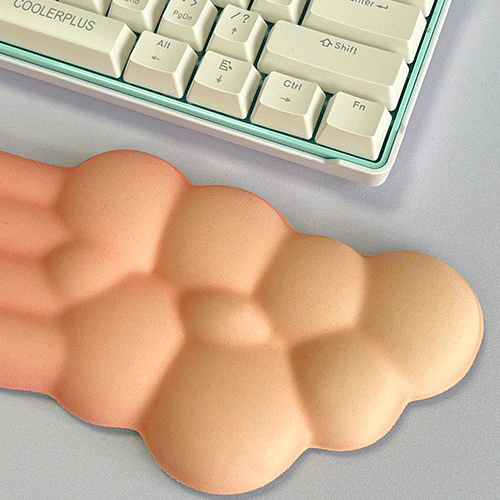News
What Material Hardness Is Required for a Rubber Wrist Rest to Provide Comfort?
In modern workplaces and gaming environments, the keyboard wrist rest has evolved from a simple accessory into an ergonomic necessity. With increasing attention on posture and hand health, the comfort and support offered by wrist rests have become key determinants of productivity and long-term user well-being. Among various materials, rubber wrist rests stand out for their resilience, durability, and cushioning. Yet, one often-overlooked factor that significantly impacts user comfort is material hardness—a parameter that defines the balance between firmness and flexibility.
Understanding how hardness levels influence tactile comfort, support distribution, and durability helps both manufacturers and end-users make informed decisions. This article explores how the right hardness for a keyboard wrist rest ensures comfort, longevity, and ergonomic precision, particularly for professionals and gamers who spend hours typing each day.
The Science of Comfort: Understanding Material Hardness
Material hardness, commonly measured by the Shore A scale, determines how resistant a rubber surface is to deformation under pressure. In the context of keyboard wrist rests, this property defines how much compression occurs when wrists are placed on the surface.
If the material is too soft (below 20 Shore A), it may feel pleasant initially but provide insufficient support, causing wrists to sink too deeply. Over time, this can lead to strain and reduce circulation. On the other hand, excessively hard materials (above 60 Shore A) can feel rigid, restricting natural wrist movement and creating discomfort during prolonged typing or gaming.
Research and ergonomic testing indicate that the optimal hardness range for wrist comfort lies between 25 to 45 Shore A. This range provides enough elasticity to absorb pressure while maintaining structural integrity.
Moreover, rubber formulations such as silicone, thermoplastic elastomers (TPE), and natural rubber can be fine-tuned within this range to achieve different tactile sensations—ranging from soft and gel-like to firm and supportive.
Material Selection and Ergonomic Balance
Comfort in a rubber wrist rest depends not only on hardness but also on the interplay between material density, surface texture, and rebound elasticity. When designed correctly, these factors create a balanced ergonomic experience that supports the user’s wrist alignment without causing fatigue.
Soft silicone materials, typically around 30 Shore A, provide gentle cushioning for sensitive wrists, making them ideal for extended computer work. For users seeking a firmer touch, TPE-based rubbers at 40–45 Shore A offer better resistance to deformation while maintaining flexibility.
An additional layer of comfort can be achieved by incorporating memory foam cores or gel infusions within the rubber shell. This hybrid design merges the structural durability of rubber with the contour-adaptive comfort of foam, improving both pressure distribution and tactile feedback.
Environmental and Durability Considerations
Another crucial factor in defining the best hardness lies in environmental resilience. A keyboard wrist rest often endures repeated compression, exposure to oils from the skin, temperature variations, and even accidental spills. Rubber materials with medium hardness (around 35 Shore A) tend to perform best under these conditions because they resist permanent deformation while maintaining flexibility.
Furthermore, softer materials can degrade faster under UV exposure, while excessively hard compounds risk cracking or surface stiffening over time. High-quality silicone-based wrist rests balance longevity and comfort by resisting oxidation, moisture, and mechanical wear.
From a sustainability perspective, recyclable synthetic rubbers with stable hardness ratings also align with modern eco-friendly manufacturing goals, extending product lifespan and reducing waste.
Design Engineering and User-Centric Adjustments
Designing a keyboard wrist rest is not merely about material selection—it involves human-centered engineering. The chosen hardness affects several design aspects, including height, slope, and curvature.
Ergonomic studies reveal that a wrist rest should support the palms lightly while allowing the wrists to hover at or slightly above keyboard level. With the right hardness, rubber materials can maintain consistent elevation under load without collapsing. For example, at 35–40 Shore A, the rubber provides stable positioning for standard desktop keyboards while still accommodating micro-adjustments as users type.
Moreover, manufacturers increasingly use dual-hardness molding, combining soft edges with firmer cores. This design innovation enhances tactile comfort and structural stability simultaneously, reducing pressure points that contribute to wrist fatigue.

Testing Comfort in Real-World Applications
Before mass production, keyboard wrist rests undergo extensive testing under real-world conditions. Engineers assess surface resilience, rebound rate, and user comfort during long-term typing sessions. Hardness variation plays a central role in these evaluations.
Tests often show that users prefer slightly softer materials for gaming or creative work—where continuous wrist movement is common—while professional typists favor firmer support for precision and alignment. The adaptability of rubber formulations allows manufacturers to produce multiple hardness grades to meet diverse ergonomic needs.
The Relationship Between Hardness and Aesthetics
While comfort remains the primary goal, the aesthetic design of a rubber wrist rest also depends on material hardness. Softer materials allow for seamless contouring and elegant curves, giving a modern, minimalistic appearance. Conversely, slightly firmer compounds enable sharp edges and embossed patterns, offering a professional or industrial design appeal.
Custom surface coatings, such as matte finishes or anti-slip textures, are easier to apply when the underlying rubber has a balanced hardness level, ensuring both durability and visual refinement.
Conclusion
In summary, achieving comfort and performance in rubber keyboard wrist rests requires a precise understanding of material hardness. Within the 25–45 Shore A range, rubber compounds deliver the ideal balance of softness, stability, and longevity. Properly engineered hardness enhances wrist support, reduces strain, and ensures the product remains durable across daily use conditions.
For manufacturers like Fulida, specializing in custom rubber accessories, mastering hardness optimization means delivering wrist rests that not only meet ergonomic expectations but also reinforce brand reputation through quality and innovation.
As digital workspaces evolve and user comfort becomes a key ergonomic priority, selecting the right rubber hardness will remain a defining factor in the next generation of keyboard wrist rest design.
Categories
News
Contact Us
Contact: Dongguan Fulida Rubber Products Co., Ltd
Tel: +86 0752-6806686
E-mail: fay@fulidarubber.com